Nursing Case Study: Assessment, Plan & Discharge for George Orwell
VerifiedAdded on 2022/09/23
|9
|3201
|23
Case Study
AI Summary
This nursing case study focuses on Mr. George Orwell, a 68-year-old widower admitted with chest pain, indicative of a myocardial infarction. His history includes multiple cardiometabolic diseases and risk factors like smoking and alcohol. The report delves into the pathophysiology of his condition, identifying acute pain and anxiety as key nursing problems. It details pain assessment using the NPRS scale, and intervention with Cox-2 inhibitors, alongside anxiety assessment via DSM-5 and interventions like relaxation techniques. The case study emphasizes the importance of discharge planning, involving a multidisciplinary team to ensure continuity of care, especially considering his rural living situation. The conclusion highlights the complexities of his health issues, non-adherence to medications, and the need for comprehensive and holistic nursing care.
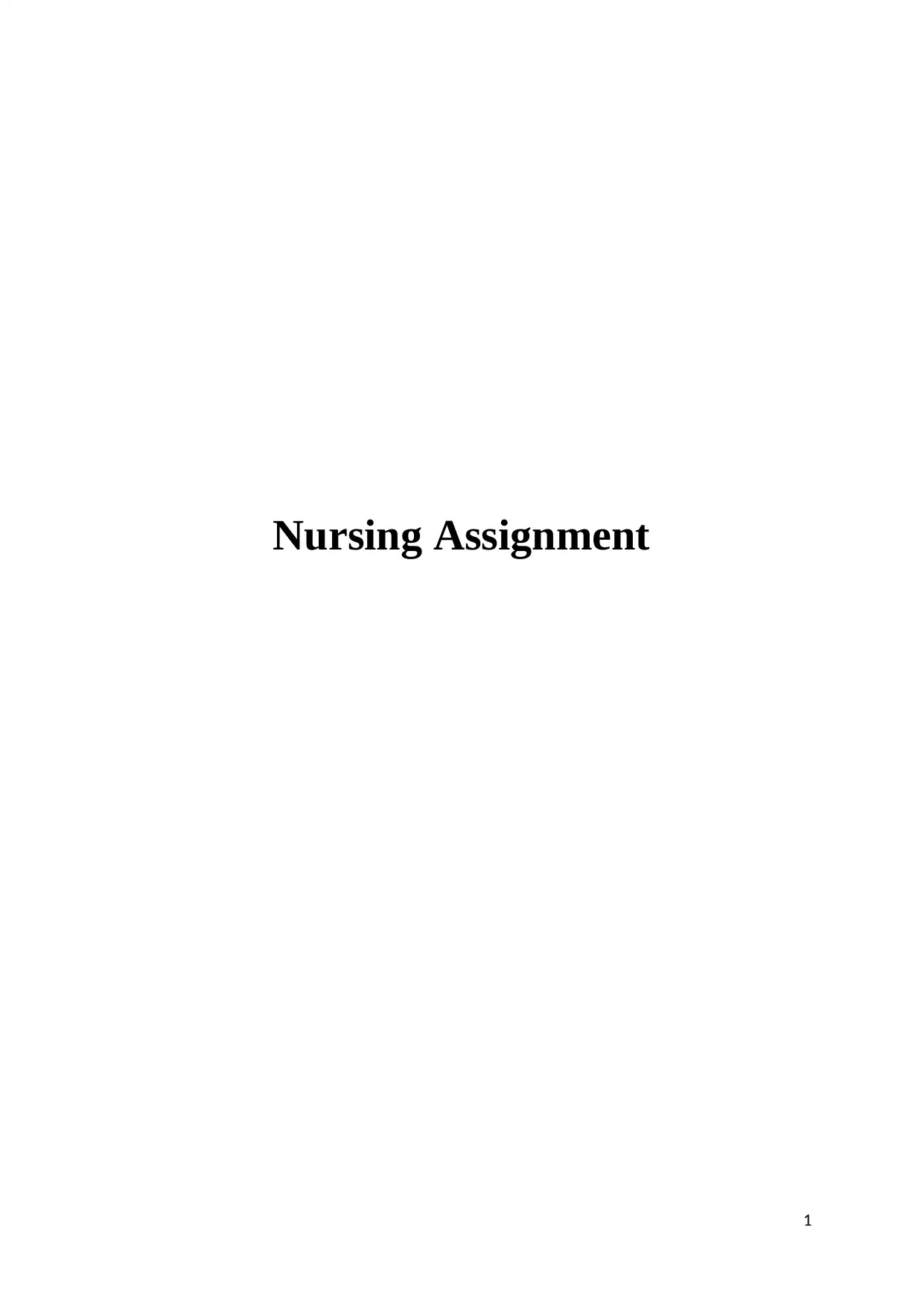
Nursing Assignment
1
1
Paraphrase This Document
Need a fresh take? Get an instant paraphrase of this document with our AI Paraphraser
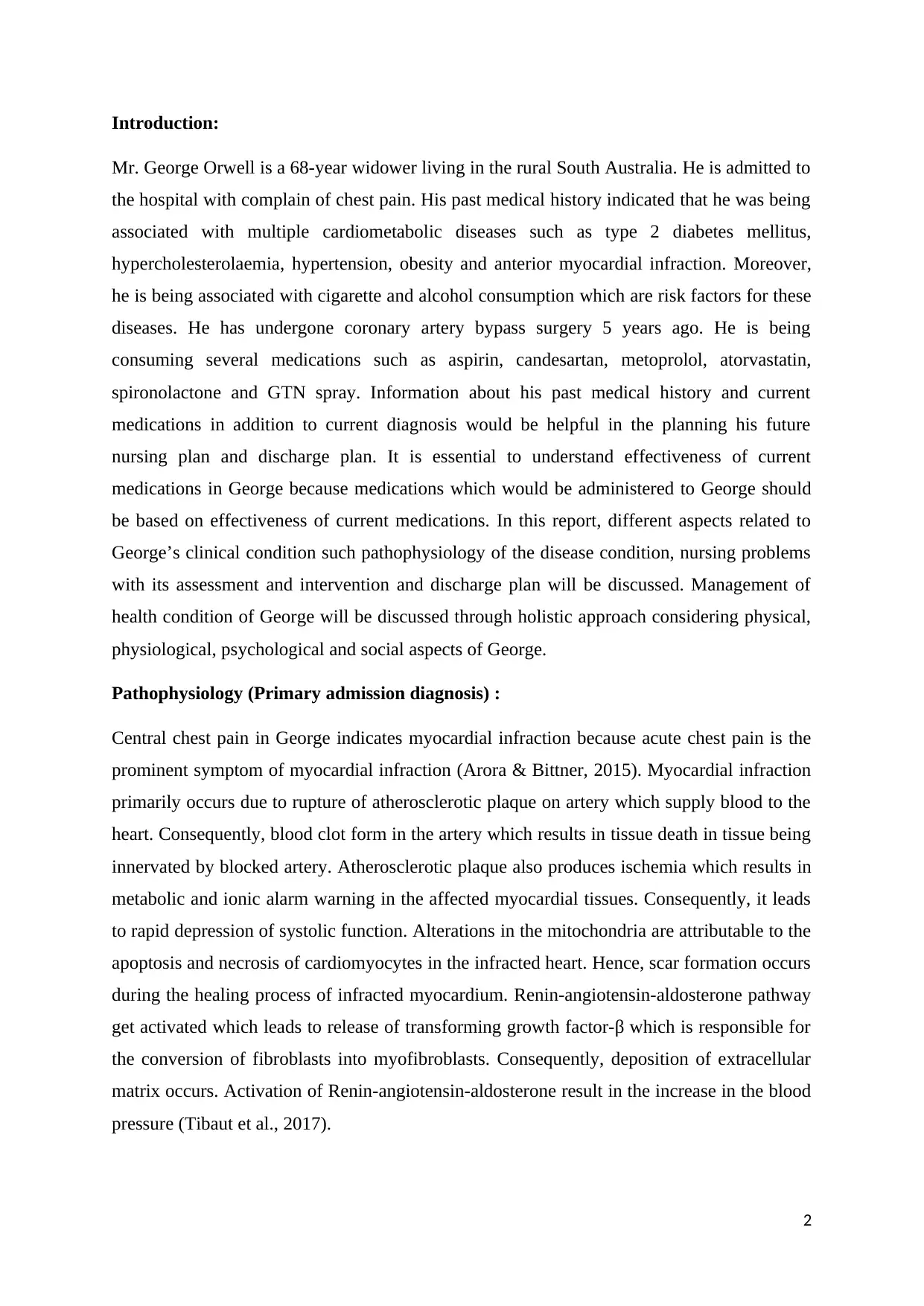
Introduction:
Mr. George Orwell is a 68-year widower living in the rural South Australia. He is admitted to
the hospital with complain of chest pain. His past medical history indicated that he was being
associated with multiple cardiometabolic diseases such as type 2 diabetes mellitus,
hypercholesterolaemia, hypertension, obesity and anterior myocardial infraction. Moreover,
he is being associated with cigarette and alcohol consumption which are risk factors for these
diseases. He has undergone coronary artery bypass surgery 5 years ago. He is being
consuming several medications such as aspirin, candesartan, metoprolol, atorvastatin,
spironolactone and GTN spray. Information about his past medical history and current
medications in addition to current diagnosis would be helpful in the planning his future
nursing plan and discharge plan. It is essential to understand effectiveness of current
medications in George because medications which would be administered to George should
be based on effectiveness of current medications. In this report, different aspects related to
George’s clinical condition such pathophysiology of the disease condition, nursing problems
with its assessment and intervention and discharge plan will be discussed. Management of
health condition of George will be discussed through holistic approach considering physical,
physiological, psychological and social aspects of George.
Pathophysiology (Primary admission diagnosis) :
Central chest pain in George indicates myocardial infraction because acute chest pain is the
prominent symptom of myocardial infraction (Arora & Bittner, 2015). Myocardial infraction
primarily occurs due to rupture of atherosclerotic plaque on artery which supply blood to the
heart. Consequently, blood clot form in the artery which results in tissue death in tissue being
innervated by blocked artery. Atherosclerotic plaque also produces ischemia which results in
metabolic and ionic alarm warning in the affected myocardial tissues. Consequently, it leads
to rapid depression of systolic function. Alterations in the mitochondria are attributable to the
apoptosis and necrosis of cardiomyocytes in the infracted heart. Hence, scar formation occurs
during the healing process of infracted myocardium. Renin-angiotensin-aldosterone pathway
get activated which leads to release of transforming growth factor-β which is responsible for
the conversion of fibroblasts into myofibroblasts. Consequently, deposition of extracellular
matrix occurs. Activation of Renin-angiotensin-aldosterone result in the increase in the blood
pressure (Tibaut et al., 2017).
2
Mr. George Orwell is a 68-year widower living in the rural South Australia. He is admitted to
the hospital with complain of chest pain. His past medical history indicated that he was being
associated with multiple cardiometabolic diseases such as type 2 diabetes mellitus,
hypercholesterolaemia, hypertension, obesity and anterior myocardial infraction. Moreover,
he is being associated with cigarette and alcohol consumption which are risk factors for these
diseases. He has undergone coronary artery bypass surgery 5 years ago. He is being
consuming several medications such as aspirin, candesartan, metoprolol, atorvastatin,
spironolactone and GTN spray. Information about his past medical history and current
medications in addition to current diagnosis would be helpful in the planning his future
nursing plan and discharge plan. It is essential to understand effectiveness of current
medications in George because medications which would be administered to George should
be based on effectiveness of current medications. In this report, different aspects related to
George’s clinical condition such pathophysiology of the disease condition, nursing problems
with its assessment and intervention and discharge plan will be discussed. Management of
health condition of George will be discussed through holistic approach considering physical,
physiological, psychological and social aspects of George.
Pathophysiology (Primary admission diagnosis) :
Central chest pain in George indicates myocardial infraction because acute chest pain is the
prominent symptom of myocardial infraction (Arora & Bittner, 2015). Myocardial infraction
primarily occurs due to rupture of atherosclerotic plaque on artery which supply blood to the
heart. Consequently, blood clot form in the artery which results in tissue death in tissue being
innervated by blocked artery. Atherosclerotic plaque also produces ischemia which results in
metabolic and ionic alarm warning in the affected myocardial tissues. Consequently, it leads
to rapid depression of systolic function. Alterations in the mitochondria are attributable to the
apoptosis and necrosis of cardiomyocytes in the infracted heart. Hence, scar formation occurs
during the healing process of infracted myocardium. Renin-angiotensin-aldosterone pathway
get activated which leads to release of transforming growth factor-β which is responsible for
the conversion of fibroblasts into myofibroblasts. Consequently, deposition of extracellular
matrix occurs. Activation of Renin-angiotensin-aldosterone result in the increase in the blood
pressure (Tibaut et al., 2017).
2
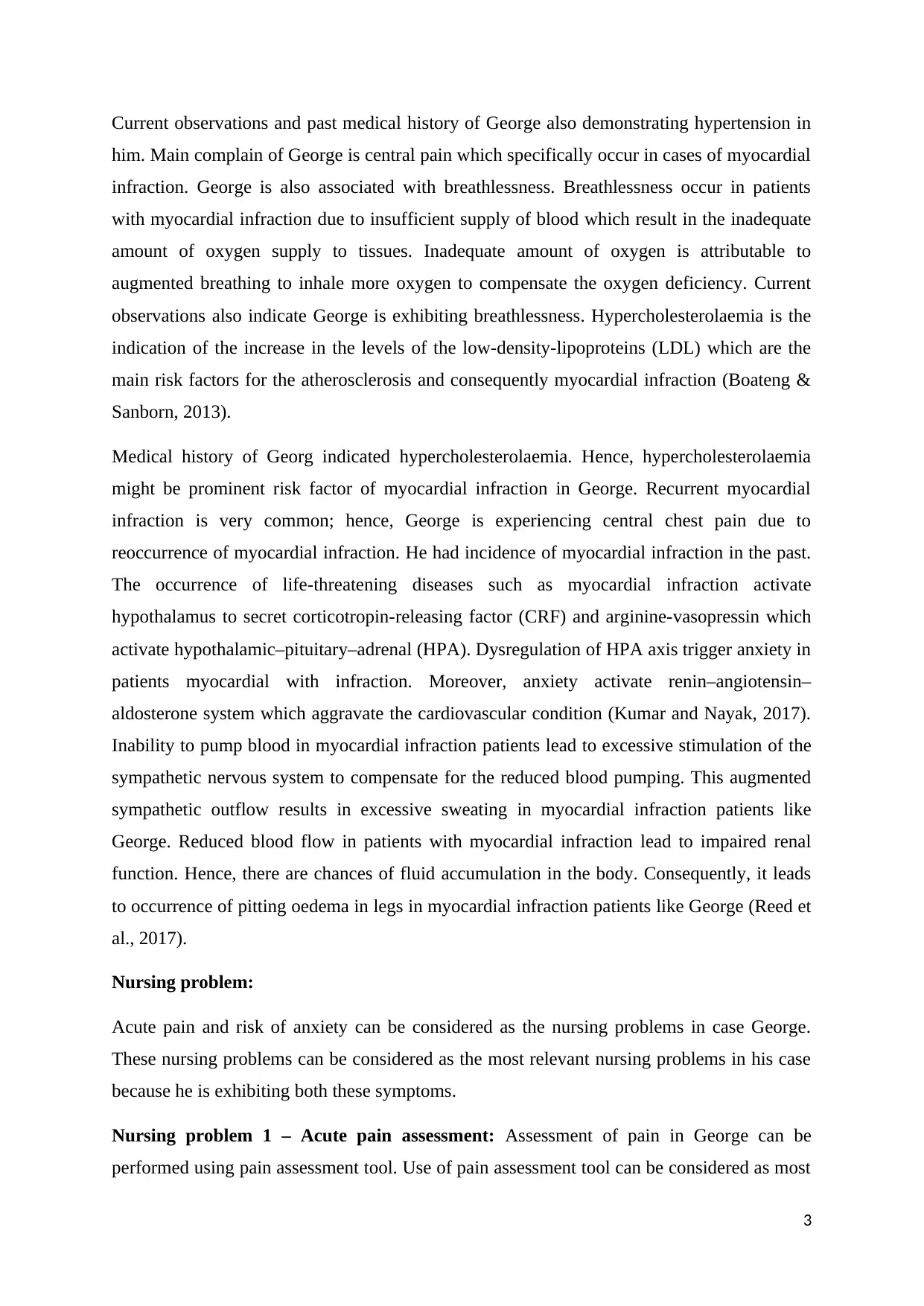
Current observations and past medical history of George also demonstrating hypertension in
him. Main complain of George is central pain which specifically occur in cases of myocardial
infraction. George is also associated with breathlessness. Breathlessness occur in patients
with myocardial infraction due to insufficient supply of blood which result in the inadequate
amount of oxygen supply to tissues. Inadequate amount of oxygen is attributable to
augmented breathing to inhale more oxygen to compensate the oxygen deficiency. Current
observations also indicate George is exhibiting breathlessness. Hypercholesterolaemia is the
indication of the increase in the levels of the low-density-lipoproteins (LDL) which are the
main risk factors for the atherosclerosis and consequently myocardial infraction (Boateng &
Sanborn, 2013).
Medical history of Georg indicated hypercholesterolaemia. Hence, hypercholesterolaemia
might be prominent risk factor of myocardial infraction in George. Recurrent myocardial
infraction is very common; hence, George is experiencing central chest pain due to
reoccurrence of myocardial infraction. He had incidence of myocardial infraction in the past.
The occurrence of life-threatening diseases such as myocardial infraction activate
hypothalamus to secret corticotropin-releasing factor (CRF) and arginine-vasopressin which
activate hypothalamic–pituitary–adrenal (HPA). Dysregulation of HPA axis trigger anxiety in
patients myocardial with infraction. Moreover, anxiety activate renin–angiotensin–
aldosterone system which aggravate the cardiovascular condition (Kumar and Nayak, 2017).
Inability to pump blood in myocardial infraction patients lead to excessive stimulation of the
sympathetic nervous system to compensate for the reduced blood pumping. This augmented
sympathetic outflow results in excessive sweating in myocardial infraction patients like
George. Reduced blood flow in patients with myocardial infraction lead to impaired renal
function. Hence, there are chances of fluid accumulation in the body. Consequently, it leads
to occurrence of pitting oedema in legs in myocardial infraction patients like George (Reed et
al., 2017).
Nursing problem:
Acute pain and risk of anxiety can be considered as the nursing problems in case George.
These nursing problems can be considered as the most relevant nursing problems in his case
because he is exhibiting both these symptoms.
Nursing problem 1 – Acute pain assessment: Assessment of pain in George can be
performed using pain assessment tool. Use of pain assessment tool can be considered as most
3
him. Main complain of George is central pain which specifically occur in cases of myocardial
infraction. George is also associated with breathlessness. Breathlessness occur in patients
with myocardial infraction due to insufficient supply of blood which result in the inadequate
amount of oxygen supply to tissues. Inadequate amount of oxygen is attributable to
augmented breathing to inhale more oxygen to compensate the oxygen deficiency. Current
observations also indicate George is exhibiting breathlessness. Hypercholesterolaemia is the
indication of the increase in the levels of the low-density-lipoproteins (LDL) which are the
main risk factors for the atherosclerosis and consequently myocardial infraction (Boateng &
Sanborn, 2013).
Medical history of Georg indicated hypercholesterolaemia. Hence, hypercholesterolaemia
might be prominent risk factor of myocardial infraction in George. Recurrent myocardial
infraction is very common; hence, George is experiencing central chest pain due to
reoccurrence of myocardial infraction. He had incidence of myocardial infraction in the past.
The occurrence of life-threatening diseases such as myocardial infraction activate
hypothalamus to secret corticotropin-releasing factor (CRF) and arginine-vasopressin which
activate hypothalamic–pituitary–adrenal (HPA). Dysregulation of HPA axis trigger anxiety in
patients myocardial with infraction. Moreover, anxiety activate renin–angiotensin–
aldosterone system which aggravate the cardiovascular condition (Kumar and Nayak, 2017).
Inability to pump blood in myocardial infraction patients lead to excessive stimulation of the
sympathetic nervous system to compensate for the reduced blood pumping. This augmented
sympathetic outflow results in excessive sweating in myocardial infraction patients like
George. Reduced blood flow in patients with myocardial infraction lead to impaired renal
function. Hence, there are chances of fluid accumulation in the body. Consequently, it leads
to occurrence of pitting oedema in legs in myocardial infraction patients like George (Reed et
al., 2017).
Nursing problem:
Acute pain and risk of anxiety can be considered as the nursing problems in case George.
These nursing problems can be considered as the most relevant nursing problems in his case
because he is exhibiting both these symptoms.
Nursing problem 1 – Acute pain assessment: Assessment of pain in George can be
performed using pain assessment tool. Use of pain assessment tool can be considered as most
3
⊘ This is a preview!⊘
Do you want full access?
Subscribe today to unlock all pages.

Trusted by 1+ million students worldwide
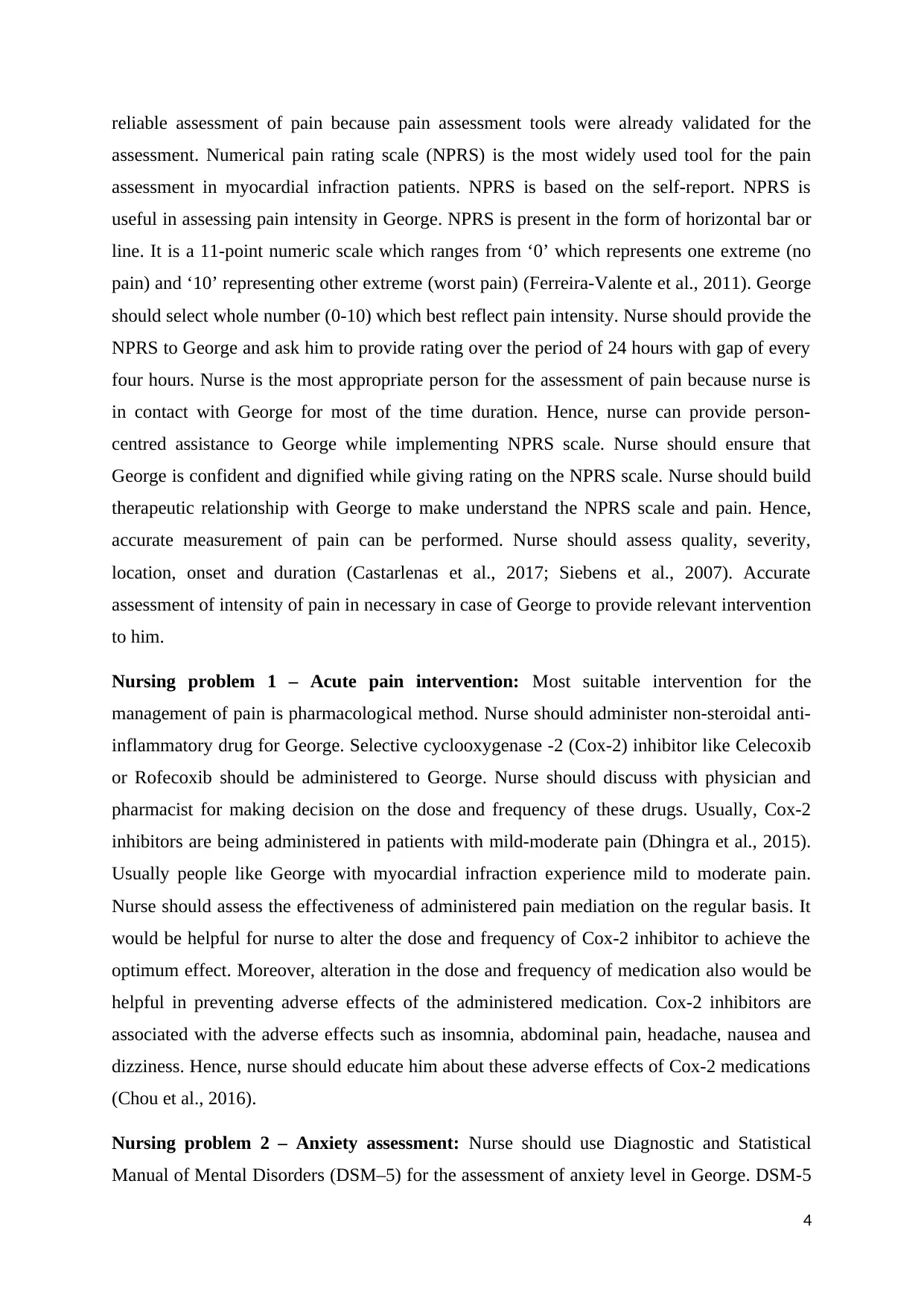
reliable assessment of pain because pain assessment tools were already validated for the
assessment. Numerical pain rating scale (NPRS) is the most widely used tool for the pain
assessment in myocardial infraction patients. NPRS is based on the self-report. NPRS is
useful in assessing pain intensity in George. NPRS is present in the form of horizontal bar or
line. It is a 11-point numeric scale which ranges from ‘0’ which represents one extreme (no
pain) and ‘10’ representing other extreme (worst pain) (Ferreira-Valente et al., 2011). George
should select whole number (0-10) which best reflect pain intensity. Nurse should provide the
NPRS to George and ask him to provide rating over the period of 24 hours with gap of every
four hours. Nurse is the most appropriate person for the assessment of pain because nurse is
in contact with George for most of the time duration. Hence, nurse can provide person-
centred assistance to George while implementing NPRS scale. Nurse should ensure that
George is confident and dignified while giving rating on the NPRS scale. Nurse should build
therapeutic relationship with George to make understand the NPRS scale and pain. Hence,
accurate measurement of pain can be performed. Nurse should assess quality, severity,
location, onset and duration (Castarlenas et al., 2017; Siebens et al., 2007). Accurate
assessment of intensity of pain in necessary in case of George to provide relevant intervention
to him.
Nursing problem 1 – Acute pain intervention: Most suitable intervention for the
management of pain is pharmacological method. Nurse should administer non-steroidal anti-
inflammatory drug for George. Selective cyclooxygenase -2 (Cox-2) inhibitor like Celecoxib
or Rofecoxib should be administered to George. Nurse should discuss with physician and
pharmacist for making decision on the dose and frequency of these drugs. Usually, Cox-2
inhibitors are being administered in patients with mild-moderate pain (Dhingra et al., 2015).
Usually people like George with myocardial infraction experience mild to moderate pain.
Nurse should assess the effectiveness of administered pain mediation on the regular basis. It
would be helpful for nurse to alter the dose and frequency of Cox-2 inhibitor to achieve the
optimum effect. Moreover, alteration in the dose and frequency of medication also would be
helpful in preventing adverse effects of the administered medication. Cox-2 inhibitors are
associated with the adverse effects such as insomnia, abdominal pain, headache, nausea and
dizziness. Hence, nurse should educate him about these adverse effects of Cox-2 medications
(Chou et al., 2016).
Nursing problem 2 – Anxiety assessment: Nurse should use Diagnostic and Statistical
Manual of Mental Disorders (DSM–5) for the assessment of anxiety level in George. DSM-5
4
assessment. Numerical pain rating scale (NPRS) is the most widely used tool for the pain
assessment in myocardial infraction patients. NPRS is based on the self-report. NPRS is
useful in assessing pain intensity in George. NPRS is present in the form of horizontal bar or
line. It is a 11-point numeric scale which ranges from ‘0’ which represents one extreme (no
pain) and ‘10’ representing other extreme (worst pain) (Ferreira-Valente et al., 2011). George
should select whole number (0-10) which best reflect pain intensity. Nurse should provide the
NPRS to George and ask him to provide rating over the period of 24 hours with gap of every
four hours. Nurse is the most appropriate person for the assessment of pain because nurse is
in contact with George for most of the time duration. Hence, nurse can provide person-
centred assistance to George while implementing NPRS scale. Nurse should ensure that
George is confident and dignified while giving rating on the NPRS scale. Nurse should build
therapeutic relationship with George to make understand the NPRS scale and pain. Hence,
accurate measurement of pain can be performed. Nurse should assess quality, severity,
location, onset and duration (Castarlenas et al., 2017; Siebens et al., 2007). Accurate
assessment of intensity of pain in necessary in case of George to provide relevant intervention
to him.
Nursing problem 1 – Acute pain intervention: Most suitable intervention for the
management of pain is pharmacological method. Nurse should administer non-steroidal anti-
inflammatory drug for George. Selective cyclooxygenase -2 (Cox-2) inhibitor like Celecoxib
or Rofecoxib should be administered to George. Nurse should discuss with physician and
pharmacist for making decision on the dose and frequency of these drugs. Usually, Cox-2
inhibitors are being administered in patients with mild-moderate pain (Dhingra et al., 2015).
Usually people like George with myocardial infraction experience mild to moderate pain.
Nurse should assess the effectiveness of administered pain mediation on the regular basis. It
would be helpful for nurse to alter the dose and frequency of Cox-2 inhibitor to achieve the
optimum effect. Moreover, alteration in the dose and frequency of medication also would be
helpful in preventing adverse effects of the administered medication. Cox-2 inhibitors are
associated with the adverse effects such as insomnia, abdominal pain, headache, nausea and
dizziness. Hence, nurse should educate him about these adverse effects of Cox-2 medications
(Chou et al., 2016).
Nursing problem 2 – Anxiety assessment: Nurse should use Diagnostic and Statistical
Manual of Mental Disorders (DSM–5) for the assessment of anxiety level in George. DSM-5
4
Paraphrase This Document
Need a fresh take? Get an instant paraphrase of this document with our AI Paraphraser
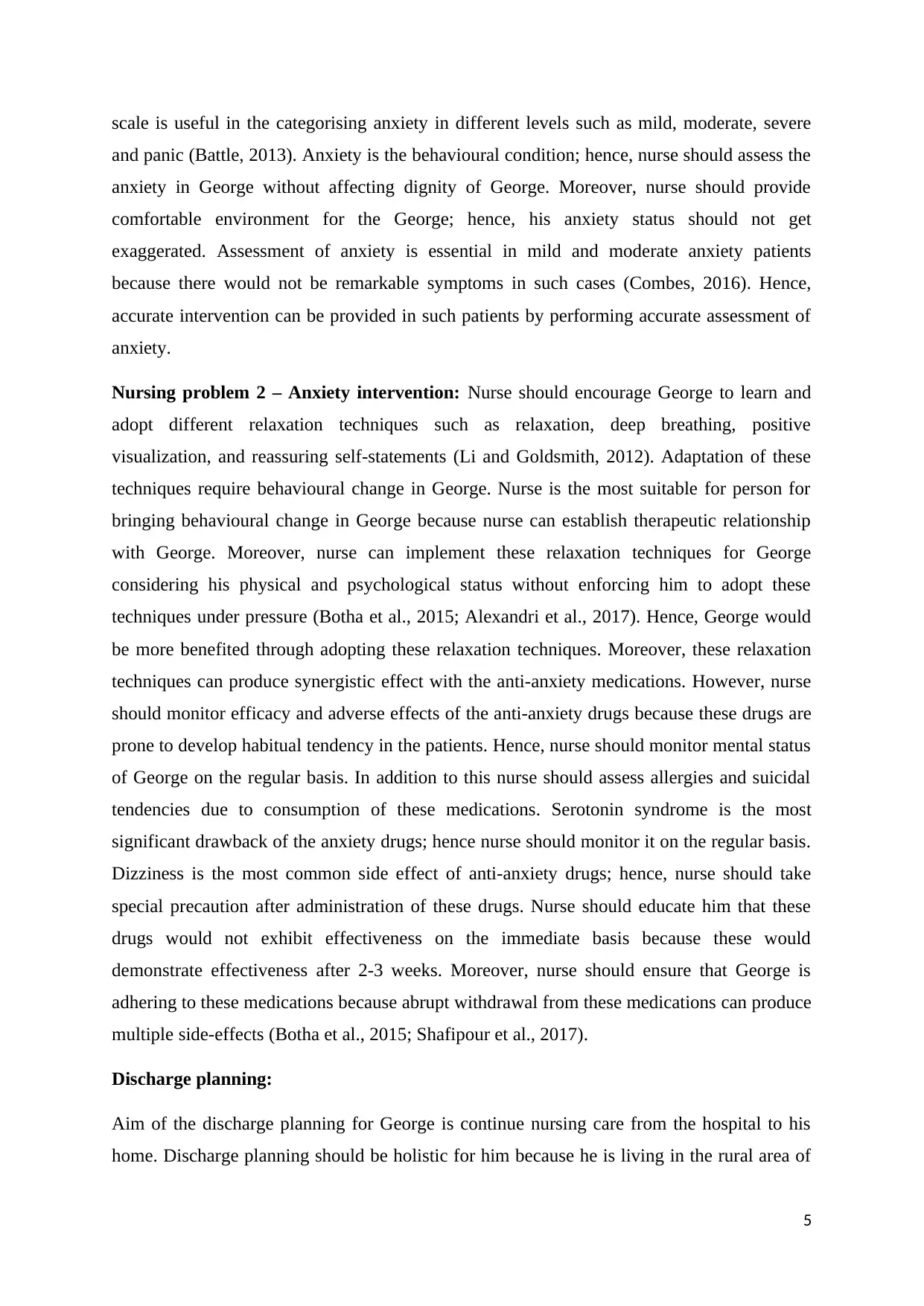
scale is useful in the categorising anxiety in different levels such as mild, moderate, severe
and panic (Battle, 2013). Anxiety is the behavioural condition; hence, nurse should assess the
anxiety in George without affecting dignity of George. Moreover, nurse should provide
comfortable environment for the George; hence, his anxiety status should not get
exaggerated. Assessment of anxiety is essential in mild and moderate anxiety patients
because there would not be remarkable symptoms in such cases (Combes, 2016). Hence,
accurate intervention can be provided in such patients by performing accurate assessment of
anxiety.
Nursing problem 2 – Anxiety intervention: Nurse should encourage George to learn and
adopt different relaxation techniques such as relaxation, deep breathing, positive
visualization, and reassuring self-statements (Li and Goldsmith, 2012). Adaptation of these
techniques require behavioural change in George. Nurse is the most suitable for person for
bringing behavioural change in George because nurse can establish therapeutic relationship
with George. Moreover, nurse can implement these relaxation techniques for George
considering his physical and psychological status without enforcing him to adopt these
techniques under pressure (Botha et al., 2015; Alexandri et al., 2017). Hence, George would
be more benefited through adopting these relaxation techniques. Moreover, these relaxation
techniques can produce synergistic effect with the anti-anxiety medications. However, nurse
should monitor efficacy and adverse effects of the anti-anxiety drugs because these drugs are
prone to develop habitual tendency in the patients. Hence, nurse should monitor mental status
of George on the regular basis. In addition to this nurse should assess allergies and suicidal
tendencies due to consumption of these medications. Serotonin syndrome is the most
significant drawback of the anxiety drugs; hence nurse should monitor it on the regular basis.
Dizziness is the most common side effect of anti-anxiety drugs; hence, nurse should take
special precaution after administration of these drugs. Nurse should educate him that these
drugs would not exhibit effectiveness on the immediate basis because these would
demonstrate effectiveness after 2-3 weeks. Moreover, nurse should ensure that George is
adhering to these medications because abrupt withdrawal from these medications can produce
multiple side-effects (Botha et al., 2015; Shafipour et al., 2017).
Discharge planning:
Aim of the discharge planning for George is continue nursing care from the hospital to his
home. Discharge planning should be holistic for him because he is living in the rural area of
5
and panic (Battle, 2013). Anxiety is the behavioural condition; hence, nurse should assess the
anxiety in George without affecting dignity of George. Moreover, nurse should provide
comfortable environment for the George; hence, his anxiety status should not get
exaggerated. Assessment of anxiety is essential in mild and moderate anxiety patients
because there would not be remarkable symptoms in such cases (Combes, 2016). Hence,
accurate intervention can be provided in such patients by performing accurate assessment of
anxiety.
Nursing problem 2 – Anxiety intervention: Nurse should encourage George to learn and
adopt different relaxation techniques such as relaxation, deep breathing, positive
visualization, and reassuring self-statements (Li and Goldsmith, 2012). Adaptation of these
techniques require behavioural change in George. Nurse is the most suitable for person for
bringing behavioural change in George because nurse can establish therapeutic relationship
with George. Moreover, nurse can implement these relaxation techniques for George
considering his physical and psychological status without enforcing him to adopt these
techniques under pressure (Botha et al., 2015; Alexandri et al., 2017). Hence, George would
be more benefited through adopting these relaxation techniques. Moreover, these relaxation
techniques can produce synergistic effect with the anti-anxiety medications. However, nurse
should monitor efficacy and adverse effects of the anti-anxiety drugs because these drugs are
prone to develop habitual tendency in the patients. Hence, nurse should monitor mental status
of George on the regular basis. In addition to this nurse should assess allergies and suicidal
tendencies due to consumption of these medications. Serotonin syndrome is the most
significant drawback of the anxiety drugs; hence nurse should monitor it on the regular basis.
Dizziness is the most common side effect of anti-anxiety drugs; hence, nurse should take
special precaution after administration of these drugs. Nurse should educate him that these
drugs would not exhibit effectiveness on the immediate basis because these would
demonstrate effectiveness after 2-3 weeks. Moreover, nurse should ensure that George is
adhering to these medications because abrupt withdrawal from these medications can produce
multiple side-effects (Botha et al., 2015; Shafipour et al., 2017).
Discharge planning:
Aim of the discharge planning for George is continue nursing care from the hospital to his
home. Discharge planning should be holistic for him because he is living in the rural area of
5
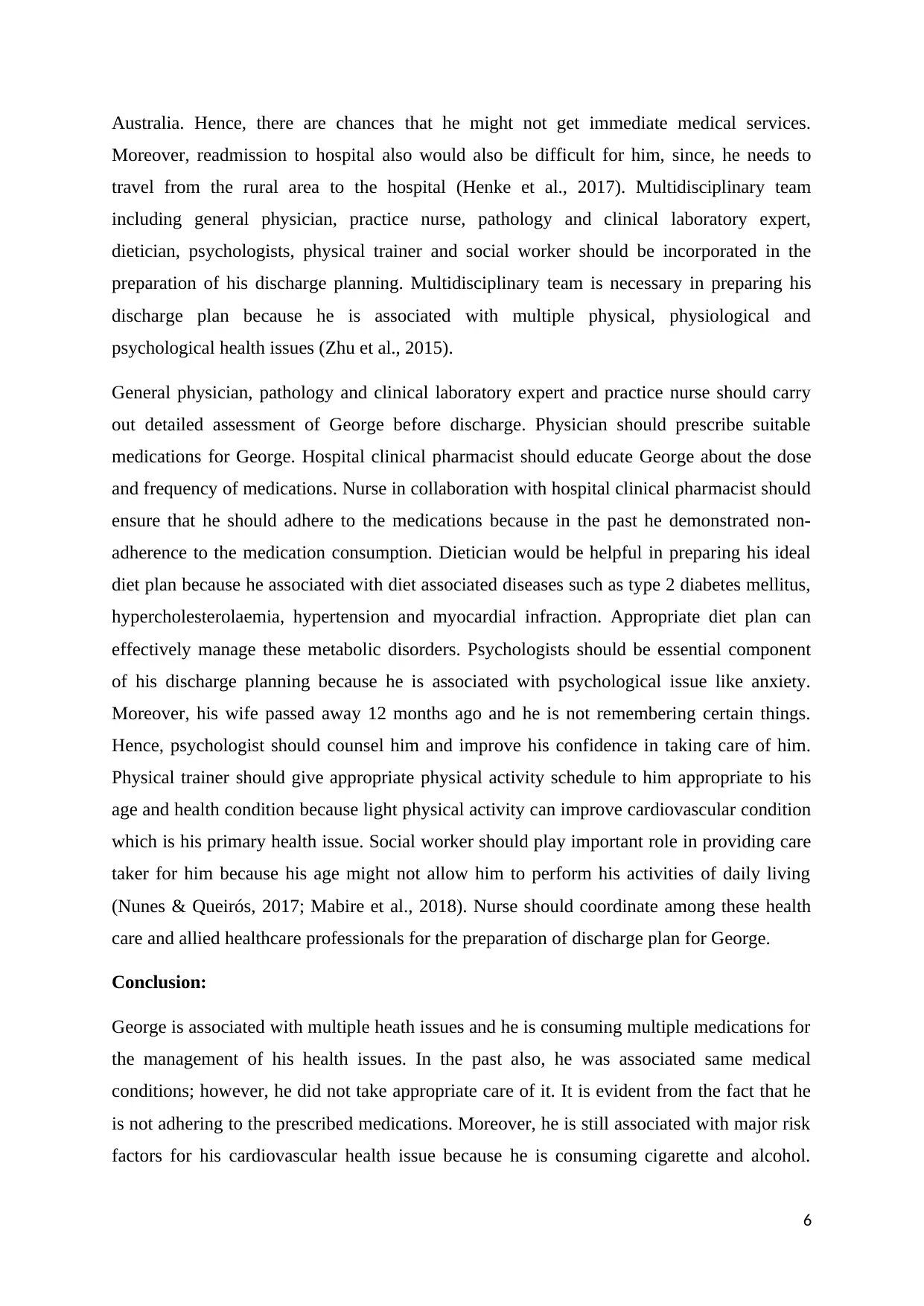
Australia. Hence, there are chances that he might not get immediate medical services.
Moreover, readmission to hospital also would also be difficult for him, since, he needs to
travel from the rural area to the hospital (Henke et al., 2017). Multidisciplinary team
including general physician, practice nurse, pathology and clinical laboratory expert,
dietician, psychologists, physical trainer and social worker should be incorporated in the
preparation of his discharge planning. Multidisciplinary team is necessary in preparing his
discharge plan because he is associated with multiple physical, physiological and
psychological health issues (Zhu et al., 2015).
General physician, pathology and clinical laboratory expert and practice nurse should carry
out detailed assessment of George before discharge. Physician should prescribe suitable
medications for George. Hospital clinical pharmacist should educate George about the dose
and frequency of medications. Nurse in collaboration with hospital clinical pharmacist should
ensure that he should adhere to the medications because in the past he demonstrated non-
adherence to the medication consumption. Dietician would be helpful in preparing his ideal
diet plan because he associated with diet associated diseases such as type 2 diabetes mellitus,
hypercholesterolaemia, hypertension and myocardial infraction. Appropriate diet plan can
effectively manage these metabolic disorders. Psychologists should be essential component
of his discharge planning because he is associated with psychological issue like anxiety.
Moreover, his wife passed away 12 months ago and he is not remembering certain things.
Hence, psychologist should counsel him and improve his confidence in taking care of him.
Physical trainer should give appropriate physical activity schedule to him appropriate to his
age and health condition because light physical activity can improve cardiovascular condition
which is his primary health issue. Social worker should play important role in providing care
taker for him because his age might not allow him to perform his activities of daily living
(Nunes & Queirós, 2017; Mabire et al., 2018). Nurse should coordinate among these health
care and allied healthcare professionals for the preparation of discharge plan for George.
Conclusion:
George is associated with multiple heath issues and he is consuming multiple medications for
the management of his health issues. In the past also, he was associated same medical
conditions; however, he did not take appropriate care of it. It is evident from the fact that he
is not adhering to the prescribed medications. Moreover, he is still associated with major risk
factors for his cardiovascular health issue because he is consuming cigarette and alcohol.
6
Moreover, readmission to hospital also would also be difficult for him, since, he needs to
travel from the rural area to the hospital (Henke et al., 2017). Multidisciplinary team
including general physician, practice nurse, pathology and clinical laboratory expert,
dietician, psychologists, physical trainer and social worker should be incorporated in the
preparation of his discharge planning. Multidisciplinary team is necessary in preparing his
discharge plan because he is associated with multiple physical, physiological and
psychological health issues (Zhu et al., 2015).
General physician, pathology and clinical laboratory expert and practice nurse should carry
out detailed assessment of George before discharge. Physician should prescribe suitable
medications for George. Hospital clinical pharmacist should educate George about the dose
and frequency of medications. Nurse in collaboration with hospital clinical pharmacist should
ensure that he should adhere to the medications because in the past he demonstrated non-
adherence to the medication consumption. Dietician would be helpful in preparing his ideal
diet plan because he associated with diet associated diseases such as type 2 diabetes mellitus,
hypercholesterolaemia, hypertension and myocardial infraction. Appropriate diet plan can
effectively manage these metabolic disorders. Psychologists should be essential component
of his discharge planning because he is associated with psychological issue like anxiety.
Moreover, his wife passed away 12 months ago and he is not remembering certain things.
Hence, psychologist should counsel him and improve his confidence in taking care of him.
Physical trainer should give appropriate physical activity schedule to him appropriate to his
age and health condition because light physical activity can improve cardiovascular condition
which is his primary health issue. Social worker should play important role in providing care
taker for him because his age might not allow him to perform his activities of daily living
(Nunes & Queirós, 2017; Mabire et al., 2018). Nurse should coordinate among these health
care and allied healthcare professionals for the preparation of discharge plan for George.
Conclusion:
George is associated with multiple heath issues and he is consuming multiple medications for
the management of his health issues. In the past also, he was associated same medical
conditions; however, he did not take appropriate care of it. It is evident from the fact that he
is not adhering to the prescribed medications. Moreover, he is still associated with major risk
factors for his cardiovascular health issue because he is consuming cigarette and alcohol.
6
⊘ This is a preview!⊘
Do you want full access?
Subscribe today to unlock all pages.

Trusted by 1+ million students worldwide
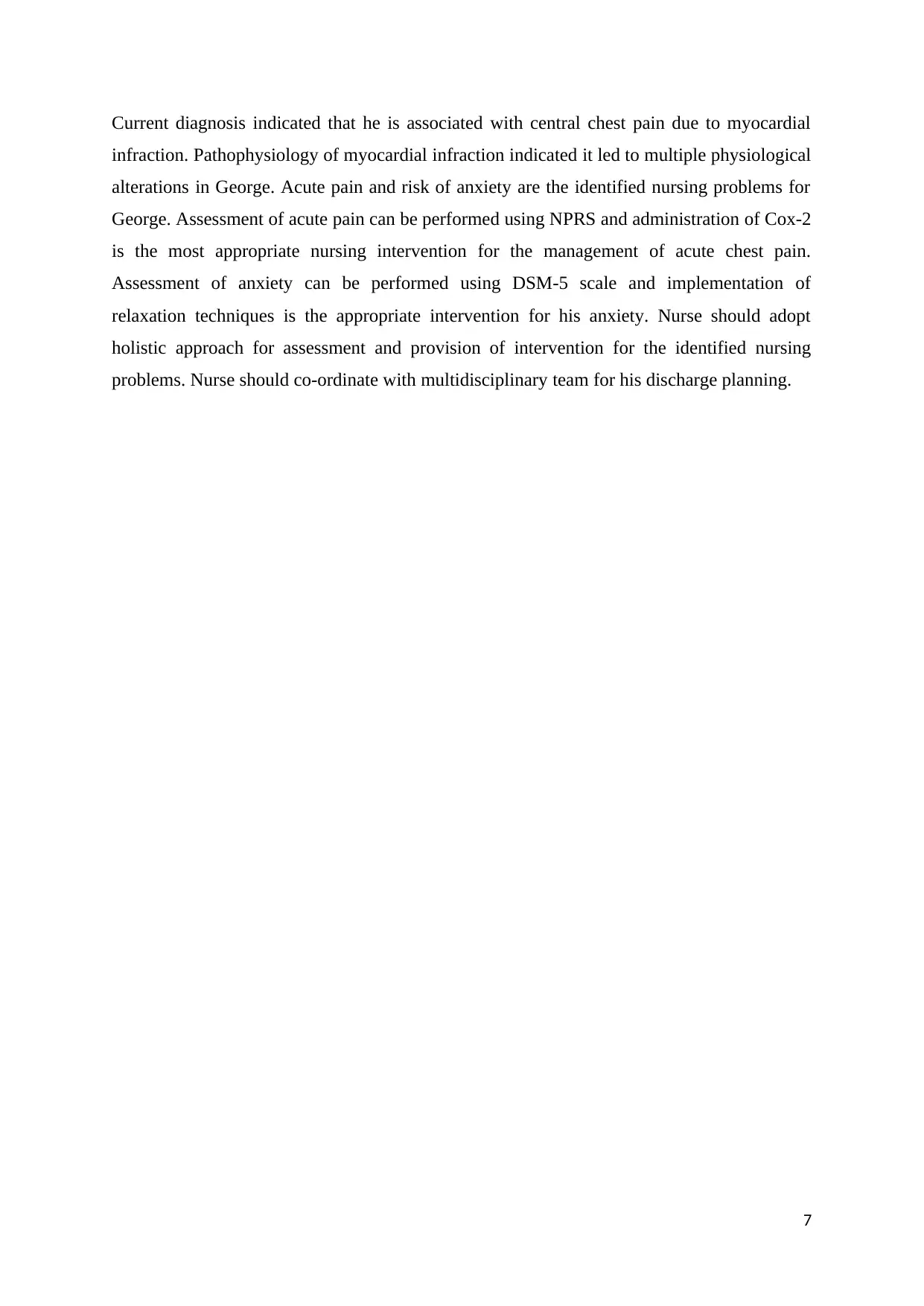
Current diagnosis indicated that he is associated with central chest pain due to myocardial
infraction. Pathophysiology of myocardial infraction indicated it led to multiple physiological
alterations in George. Acute pain and risk of anxiety are the identified nursing problems for
George. Assessment of acute pain can be performed using NPRS and administration of Cox-2
is the most appropriate nursing intervention for the management of acute chest pain.
Assessment of anxiety can be performed using DSM-5 scale and implementation of
relaxation techniques is the appropriate intervention for his anxiety. Nurse should adopt
holistic approach for assessment and provision of intervention for the identified nursing
problems. Nurse should co-ordinate with multidisciplinary team for his discharge planning.
7
infraction. Pathophysiology of myocardial infraction indicated it led to multiple physiological
alterations in George. Acute pain and risk of anxiety are the identified nursing problems for
George. Assessment of acute pain can be performed using NPRS and administration of Cox-2
is the most appropriate nursing intervention for the management of acute chest pain.
Assessment of anxiety can be performed using DSM-5 scale and implementation of
relaxation techniques is the appropriate intervention for his anxiety. Nurse should adopt
holistic approach for assessment and provision of intervention for the identified nursing
problems. Nurse should co-ordinate with multidisciplinary team for his discharge planning.
7
Paraphrase This Document
Need a fresh take? Get an instant paraphrase of this document with our AI Paraphraser
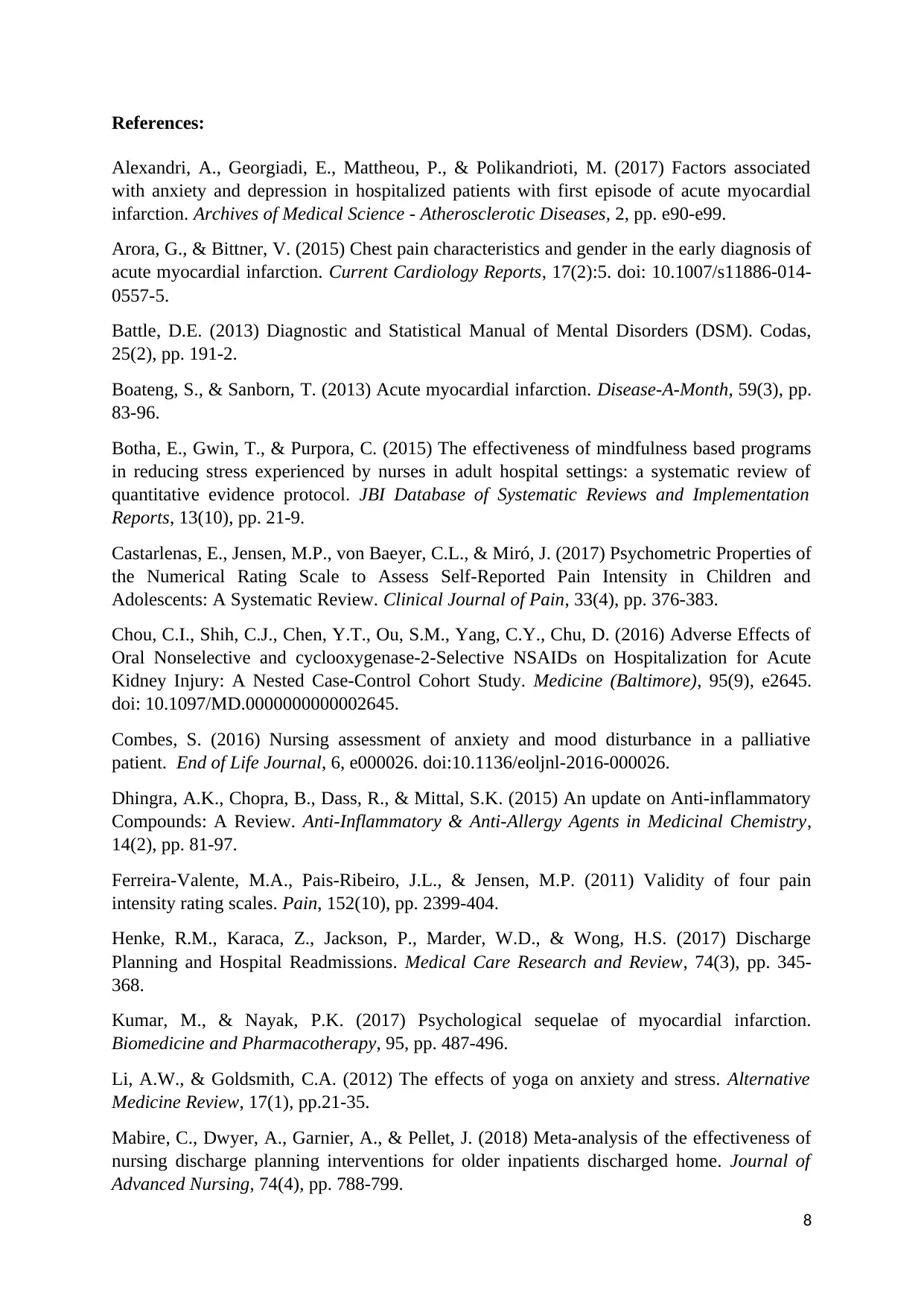
References:
Alexandri, A., Georgiadi, E., Mattheou, P., & Polikandrioti, M. (2017) Factors associated
with anxiety and depression in hospitalized patients with first episode of acute myocardial
infarction. Archives of Medical Science - Atherosclerotic Diseases, 2, pp. e90-e99.
Arora, G., & Bittner, V. (2015) Chest pain characteristics and gender in the early diagnosis of
acute myocardial infarction. Current Cardiology Reports, 17(2):5. doi: 10.1007/s11886-014-
0557-5.
Battle, D.E. (2013) Diagnostic and Statistical Manual of Mental Disorders (DSM). Codas,
25(2), pp. 191-2.
Boateng, S., & Sanborn, T. (2013) Acute myocardial infarction. Disease-A-Month, 59(3), pp.
83-96.
Botha, E., Gwin, T., & Purpora, C. (2015) The effectiveness of mindfulness based programs
in reducing stress experienced by nurses in adult hospital settings: a systematic review of
quantitative evidence protocol. JBI Database of Systematic Reviews and Implementation
Reports, 13(10), pp. 21-9.
Castarlenas, E., Jensen, M.P., von Baeyer, C.L., & Miró, J. (2017) Psychometric Properties of
the Numerical Rating Scale to Assess Self-Reported Pain Intensity in Children and
Adolescents: A Systematic Review. Clinical Journal of Pain, 33(4), pp. 376-383.
Chou, C.I., Shih, C.J., Chen, Y.T., Ou, S.M., Yang, C.Y., Chu, D. (2016) Adverse Effects of
Oral Nonselective and cyclooxygenase-2-Selective NSAIDs on Hospitalization for Acute
Kidney Injury: A Nested Case-Control Cohort Study. Medicine (Baltimore), 95(9), e2645.
doi: 10.1097/MD.0000000000002645.
Combes, S. (2016) Nursing assessment of anxiety and mood disturbance in a palliative
patient. End of Life Journal, 6, e000026. doi:10.1136/eoljnl-2016-000026.
Dhingra, A.K., Chopra, B., Dass, R., & Mittal, S.K. (2015) An update on Anti-inflammatory
Compounds: A Review. Anti-Inflammatory & Anti-Allergy Agents in Medicinal Chemistry,
14(2), pp. 81-97.
Ferreira-Valente, M.A., Pais-Ribeiro, J.L., & Jensen, M.P. (2011) Validity of four pain
intensity rating scales. Pain, 152(10), pp. 2399-404.
Henke, R.M., Karaca, Z., Jackson, P., Marder, W.D., & Wong, H.S. (2017) Discharge
Planning and Hospital Readmissions. Medical Care Research and Review, 74(3), pp. 345-
368.
Kumar, M., & Nayak, P.K. (2017) Psychological sequelae of myocardial infarction.
Biomedicine and Pharmacotherapy, 95, pp. 487-496.
Li, A.W., & Goldsmith, C.A. (2012) The effects of yoga on anxiety and stress. Alternative
Medicine Review, 17(1), pp.21-35.
Mabire, C., Dwyer, A., Garnier, A., & Pellet, J. (2018) Meta-analysis of the effectiveness of
nursing discharge planning interventions for older inpatients discharged home. Journal of
Advanced Nursing, 74(4), pp. 788-799.
8
Alexandri, A., Georgiadi, E., Mattheou, P., & Polikandrioti, M. (2017) Factors associated
with anxiety and depression in hospitalized patients with first episode of acute myocardial
infarction. Archives of Medical Science - Atherosclerotic Diseases, 2, pp. e90-e99.
Arora, G., & Bittner, V. (2015) Chest pain characteristics and gender in the early diagnosis of
acute myocardial infarction. Current Cardiology Reports, 17(2):5. doi: 10.1007/s11886-014-
0557-5.
Battle, D.E. (2013) Diagnostic and Statistical Manual of Mental Disorders (DSM). Codas,
25(2), pp. 191-2.
Boateng, S., & Sanborn, T. (2013) Acute myocardial infarction. Disease-A-Month, 59(3), pp.
83-96.
Botha, E., Gwin, T., & Purpora, C. (2015) The effectiveness of mindfulness based programs
in reducing stress experienced by nurses in adult hospital settings: a systematic review of
quantitative evidence protocol. JBI Database of Systematic Reviews and Implementation
Reports, 13(10), pp. 21-9.
Castarlenas, E., Jensen, M.P., von Baeyer, C.L., & Miró, J. (2017) Psychometric Properties of
the Numerical Rating Scale to Assess Self-Reported Pain Intensity in Children and
Adolescents: A Systematic Review. Clinical Journal of Pain, 33(4), pp. 376-383.
Chou, C.I., Shih, C.J., Chen, Y.T., Ou, S.M., Yang, C.Y., Chu, D. (2016) Adverse Effects of
Oral Nonselective and cyclooxygenase-2-Selective NSAIDs on Hospitalization for Acute
Kidney Injury: A Nested Case-Control Cohort Study. Medicine (Baltimore), 95(9), e2645.
doi: 10.1097/MD.0000000000002645.
Combes, S. (2016) Nursing assessment of anxiety and mood disturbance in a palliative
patient. End of Life Journal, 6, e000026. doi:10.1136/eoljnl-2016-000026.
Dhingra, A.K., Chopra, B., Dass, R., & Mittal, S.K. (2015) An update on Anti-inflammatory
Compounds: A Review. Anti-Inflammatory & Anti-Allergy Agents in Medicinal Chemistry,
14(2), pp. 81-97.
Ferreira-Valente, M.A., Pais-Ribeiro, J.L., & Jensen, M.P. (2011) Validity of four pain
intensity rating scales. Pain, 152(10), pp. 2399-404.
Henke, R.M., Karaca, Z., Jackson, P., Marder, W.D., & Wong, H.S. (2017) Discharge
Planning and Hospital Readmissions. Medical Care Research and Review, 74(3), pp. 345-
368.
Kumar, M., & Nayak, P.K. (2017) Psychological sequelae of myocardial infarction.
Biomedicine and Pharmacotherapy, 95, pp. 487-496.
Li, A.W., & Goldsmith, C.A. (2012) The effects of yoga on anxiety and stress. Alternative
Medicine Review, 17(1), pp.21-35.
Mabire, C., Dwyer, A., Garnier, A., & Pellet, J. (2018) Meta-analysis of the effectiveness of
nursing discharge planning interventions for older inpatients discharged home. Journal of
Advanced Nursing, 74(4), pp. 788-799.
8
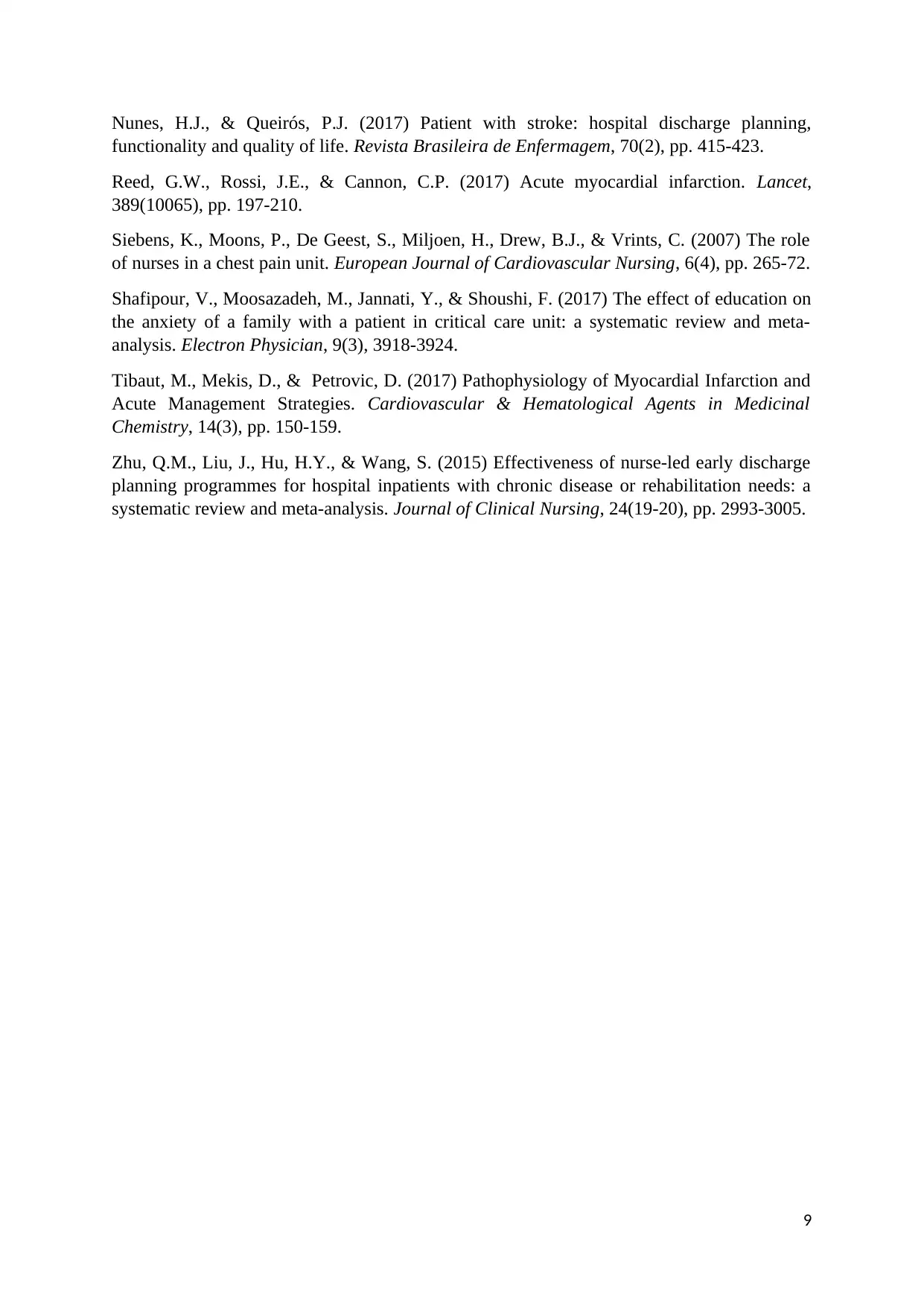
Nunes, H.J., & Queirós, P.J. (2017) Patient with stroke: hospital discharge planning,
functionality and quality of life. Revista Brasileira de Enfermagem, 70(2), pp. 415-423.
Reed, G.W., Rossi, J.E., & Cannon, C.P. (2017) Acute myocardial infarction. Lancet,
389(10065), pp. 197-210.
Siebens, K., Moons, P., De Geest, S., Miljoen, H., Drew, B.J., & Vrints, C. (2007) The role
of nurses in a chest pain unit. European Journal of Cardiovascular Nursing, 6(4), pp. 265-72.
Shafipour, V., Moosazadeh, M., Jannati, Y., & Shoushi, F. (2017) The effect of education on
the anxiety of a family with a patient in critical care unit: a systematic review and meta-
analysis. Electron Physician, 9(3), 3918-3924.
Tibaut, M., Mekis, D., & Petrovic, D. (2017) Pathophysiology of Myocardial Infarction and
Acute Management Strategies. Cardiovascular & Hematological Agents in Medicinal
Chemistry, 14(3), pp. 150-159.
Zhu, Q.M., Liu, J., Hu, H.Y., & Wang, S. (2015) Effectiveness of nurse-led early discharge
planning programmes for hospital inpatients with chronic disease or rehabilitation needs: a
systematic review and meta-analysis. Journal of Clinical Nursing, 24(19-20), pp. 2993-3005.
9
functionality and quality of life. Revista Brasileira de Enfermagem, 70(2), pp. 415-423.
Reed, G.W., Rossi, J.E., & Cannon, C.P. (2017) Acute myocardial infarction. Lancet,
389(10065), pp. 197-210.
Siebens, K., Moons, P., De Geest, S., Miljoen, H., Drew, B.J., & Vrints, C. (2007) The role
of nurses in a chest pain unit. European Journal of Cardiovascular Nursing, 6(4), pp. 265-72.
Shafipour, V., Moosazadeh, M., Jannati, Y., & Shoushi, F. (2017) The effect of education on
the anxiety of a family with a patient in critical care unit: a systematic review and meta-
analysis. Electron Physician, 9(3), 3918-3924.
Tibaut, M., Mekis, D., & Petrovic, D. (2017) Pathophysiology of Myocardial Infarction and
Acute Management Strategies. Cardiovascular & Hematological Agents in Medicinal
Chemistry, 14(3), pp. 150-159.
Zhu, Q.M., Liu, J., Hu, H.Y., & Wang, S. (2015) Effectiveness of nurse-led early discharge
planning programmes for hospital inpatients with chronic disease or rehabilitation needs: a
systematic review and meta-analysis. Journal of Clinical Nursing, 24(19-20), pp. 2993-3005.
9
⊘ This is a preview!⊘
Do you want full access?
Subscribe today to unlock all pages.

Trusted by 1+ million students worldwide
1 out of 9
Related Documents
Your All-in-One AI-Powered Toolkit for Academic Success.
+13062052269
info@desklib.com
Available 24*7 on WhatsApp / Email
![[object Object]](/_next/static/media/star-bottom.7253800d.svg)
Unlock your academic potential
Copyright © 2020–2025 A2Z Services. All Rights Reserved. Developed and managed by ZUCOL.





